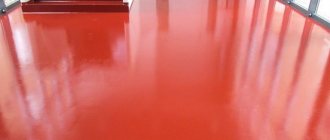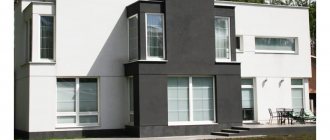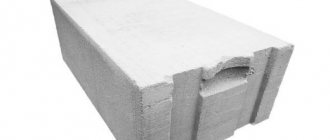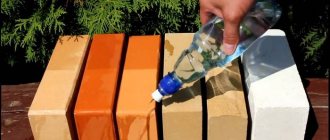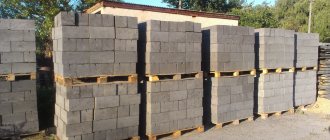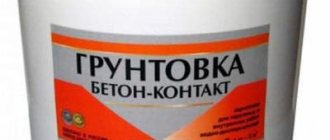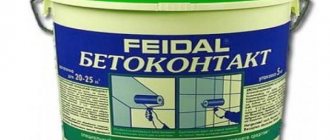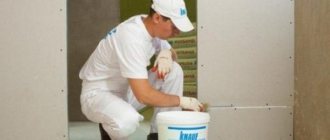It would seem that what could be easier than understanding the principle of operation of a concrete contact and using it according to the instructions? Bought it, mixed it, applied it, and then do whatever you want: plaster, tile, apply any finish. However, practice shows that in reality everything is not so rosy. Repairs using concrete contact soils sometimes turn into real torture. In this article we will tell you which surfaces need the use of concrete contacts, and where you can do without it. We’ll also talk about the cost and economical application of this type of primer.
Advantages and disadvantages
The almost “magical” material has more of the former, but there are also some disadvantages.
First you need to give a list of advantages. These include:
- Versatility. The mixture does not require tedious and thorough surface preparation before application. The only conditions are their smoothness and inability to absorb moisture excessively.
- High strength. The dried layer of concrete contact is not afraid of any construction work. Cracks will not appear even when drilling.
- The ability to make porous surfaces maximally protected from moisture. This applies to gypsum, wood, brick and foam and aerated concrete.
- Absolute immunity of the dried material to significant temperature changes. However, it can be applied if it is above +5° outside.
- Environmentally friendly. The adhesive composition does not contain any toxic substances that would make the primer unsuitable for interior work.
- High drying speed. A few hours after surface treatment, you can begin further finishing work.
- Durability of the layer. Manufacturers claim that the primer does not lose quality for 80 years.
- Complete absence of fear of ultraviolet radiation and fire safety.
- Vapor permeability due to polymers that can “breathe”.
This list can include the uselessness of a gauze bandage, which was previously used to fix “unruly” plaster, and the ease of work for beginners: spreading pink “sour cream” on the surface (but not on the ceiling) is quite simple.
The disadvantages of concrete contact are still relative. This:
- fear of dust, it requires mandatory preliminary dust removal of surfaces;
- the need for constant stirring due to the fact that heavy ingredients “strive” to settle to the bottom.
As you can see, advantages take precedence over disadvantages, which may not be considered such at all. Many positive qualities make concrete contact a truly unique material, guaranteeing convenience, speed of work and reliable finishing.
What is it, why is it needed, what are its features?
Betonokontakt is an acrylic-based plaster primer to increase adhesion. The intended purpose is to pre-coat a dense, smooth, water-repellent work area.
The composition contains polymers, quartz sand, acrylic, which makes the substance environmentally friendly.
The liquid applied to the walls/ceiling/floor fills small cracks, pores, and irregularities, forming a smooth, integral plane. After covering with concrete contact, the bases will not absorb much of the adhesive solution. No air pockets or small bubbles will appear. These factors significantly extend the period of durable adhesion of the coating and improve the quality of the finish.
Example of concrete contact composition
The big advantage of the substance is that it is non-toxic. It can be used inside a home where small children live and there are pets.
Due to the content of quartz sand, the necessary degree of roughness is noted for better adhesion.
Craftsmen note quick drying, economical consumption per square meter, and durability. The solution resists the influence of humidity and temperature changes.
Recommendations for surgery
In order to do the job flawlessly on the first try, it is better to listen (heed?) to the advice that masters share with beginners.
Purchase and preparation of the composition
- Buying a quality product that has many positive reviews is the only way to protect yourself from all kinds of counterfeits. Checking the packaging (expiration date) and quality certificate “without leaving the checkout” will give you a chance to purchase a fresh and efficiently working product.
- If you are not sure which primer is needed for a particular surface, then it is better to get all the information from sales consultants. They will lay out all the necessary information - about the manufacturer, about the concrete contact: consumption, features of the types available for sale.
- After opening the package, the primer, which is similar in consistency to paint, is also thoroughly mixed, for example, with a mixer attachment. An obstacle to applying concrete contact is a high level of humidity (more than 75%). It will not allow the material to dry “correctly”.
The homogeneity of the mixture is the first sign of a quality product. Any lumps in a freshly opened container indicate the opposite.
Surfaces and work
Betonokontakt does not like greasy stains on the paint, so problem areas are washed (wipe) with a sponge, then degreased. The use of a regular primer will allow you to slightly reduce consumption, since it will do its job - it will fill all the cracks in the base. Large and small debris, dirt, unevenness or suspicious areas that threaten to soon crumble are the obstacles that will have to be gotten rid of. A necessary condition for work is a clean but completely dry base. Surfaces that absorb liquid well are a sufficient reason to apply two layers of concrete contact. If the base has serious defects or unusual relief, then re-processing of this problematic surface is also required. The tool is selected based on convenience and surface area. It can be a roller, brush, spray gun
In the latter case, it is important that the size of the nozzle does not interfere with the exit of the mixture components. Wide brushes are ideal
Rollers, on the contrary, increase consumption by absorbing a large amount of the composition. Mandatory drying of each layer, regardless of their number, is a rule that applies to almost all construction work. However, you should not hesitate to fix the finishing material onto the last dried layer. Otherwise, enough dust will settle on it, and it will reduce the contact strength. Protection of the base from it is necessary. If 48 hours have passed after applying the concrete contact, then a new surface treatment will be required: this time with ordinary deep penetration soil.
If not all of the concrete contact is used, then the packaging is stored at room temperature. Sending it to “winter” on an open balcony is prohibited: since after freezing the primer loses its unique properties. The shelf life of the material is from 6 to 12 months.
How to prepare the mixture?
Often there is no need to prepare this mixture - manufacturers are ready to sell a completely ready-made solution. When purchasing such a concrete contact, it is enough to stir all the contents until smooth. It must be remembered that it can only be stored at positive temperatures.
Nowadays, few people prepare such mixtures with their own hands, because you need to know exactly the proportions, buy all the necessary materials, and also dilute them correctly with water. Then you need to wait and watch how the solution thickens. This is extremely energy-consuming, so everyone buys ready-made concrete contacts. You just need to read the instructions for use and work with this composition correctly.
Preparing concrete walls for plastering
The process of preparing interior concrete walls for plastering consists of the following steps:
- The old coating in the form of fragile plaster, whitewash, paint is removed (in which cases it is possible to apply plaster over old paint, we recommend reading here);
- Defects in concrete walls are determined. If there are nodules, they are cut down using a hammer and chisel. Massive chips and deep cavities are sealed with cement-sand mortar in a ratio of 1:3; if necessary, steel mesh is used for reinforcement;
- On smooth walls, notches are made using a hammer and chisel, the maximum notch spacing is 10 cm;
- If it is necessary to install hidden wiring, grooves are made for the wires;
- The concrete surface is cleaned. A brush and water are used to remove dust and dirt. The wall can be treated using compressed air or a strong jet of water, which will significantly speed up the cleaning process;
- A primer is applied to the wall surface.
Notches on a concrete wall
We'll talk more about the types of primers for concrete walls below.
Priming concrete walls before plastering
Priming of concrete walls is necessary for the following purposes:
- Reducing the absorption of water from the solution into the concrete base;
- Protecting a concrete wall from the formation of fungus and mold;
- Increasing the strength of the protective (surface) layer of concrete;
- Dust removal from the concrete surface. The primer binds dust particles and makes the base clean;
- Improving the adhesion of plaster mortar to a concrete base.
Applying primer to a concrete wall
Next, we will look at how to prime concrete walls before plastering:
- For smooth concrete surfaces, concrete contact primers are ideal. After application, the composition fills the pores in the concrete, and a rough layer with high adhesion is formed on the surface, facilitating good adhesion to future plaster. We recommend compositions from the following manufacturers: Feidel Betokontakt, Knauf Betokontakt, Prospector Beton-Kontakt.
- Old concrete surfaces can be strengthened using a deep penetration primer designed specifically for impregnating weak substrates. Such soil impregnates the top layer of concrete, thereby strengthening it and giving it the necessary strength. Among the manufacturers we recommend: Prospectors “Deep Penetration”, AquaNova “Nova”, Acrylic Optimist “Deep Penetration”.
Primer Prospectors "Deep Penetration"
To prepare porous concrete surfaces (aerated concrete, foam concrete), primers are needed that reduce the absorbency of the base, thereby preventing uneven setting of the solution. The following primers are perfect: Knauf Mittelgrund, Knauf Rotband Grund (for gypsum plasters), Ceresit ST 17, Toiler TR10.
When applying primer to the substrate, be sure to follow the manufacturer's instructions. As a rule, the primer must be shaken before application, and the application process itself must be carried out in several layers.
Installation of beacons and reinforcing mesh
If the old wall has differences of more than 10 mm, then it is necessary to install beacons before applying plaster. Beacons are needed for even application of plaster with an equal layer of thickness. It is better to use metal profiles as beacons.
Lighthouses on a concrete wall
If the thickness of the planned plaster is more than 20 mm, then it is necessary to additionally install a reinforcing mesh. The mesh is fastened to the wall using dowel nails.
Next, you need to prepare the solution in accordance with the manufacturer's instructions. To avoid the formation of lumps, add water to the dry mixture, and not vice versa.
Scope of application of this material
The first thing I would like to note is that concrete contact is not cheap, that is, it is much more expensive than a regular primer. Why is it practical to use it?
The scope of application of this material is quite wide, since its properties are unique.
Concrete contact is most often used in these cases:
- it is necessary to glue together two completely different materials (glass and tile), for example, the surface to which something needs to be glued is glossy and smooth, for example, because it is painted with old oil paint. Concrete contact will make this surface rough and ensure good adhesion.
- when you want to skip the long and tedious preparation stage. In a good way, paint and whitewash must be removed before starting other work. That is, if you decide to lay tiles, then first you need to knock off the paint layer. But if the paint holds up well, why do it and spend so much time? Or you want to putty on a whitewashed ceiling. But if the whitewash holds well, why wash it off? It is better to use concrete contact, which is ideal in all these situations.
- you apply a thick layer of plaster to the surface and doubt that it will stay on it in the future;
- plastered surfaces are preserved for the winter. In this case, a somewhat simplified version of concrete contact is used.
Concrete contact primer: features and consumption per 1m2
A primer is a unique solution that is used to prepare a specific surface for finishing, such as painting. The use of such a building mixture allows you to level the surface, get rid of any defects on the wall and eliminate small cracks.
One of the most popular types of primer is concrete contact, the use of which greatly simplifies further finishing work.
Main characteristics and properties
Concrete contact is a building mixture based on acrylic, which also includes cement, sand and special additives. This mixture is actively used to increase the adhesion of surfaces that do not absorb moisture well, before plastering, laying tiles and carrying out other finishing work.
Among its main advantages are the following:
- high drying speed. Further finishing work can begin a few hours after applying the primer;
- resistance to moisture. During the drying process, a special film is formed that does not allow water to pass through;
- durability. According to the manufacturing company, the concrete contact primer does not lose its qualities for 80 years.
Thanks to its unsurpassed properties, concrete contact has established itself as a unique material that is durable, does not require a lot of drying time and does not allow moisture to pass through. It is these properties that allow you not to worry about the quality of the repairs done.
How to determine the consumption of concrete contact?
The consumption of concrete contact per 1 m2 depends on many factors, among which the first place is occupied by the characteristics of the treated surface
It is not the type of surface itself that is important, but the porosity. It determines how much primer will be absorbed, which has a direct impact on its consumption per m2
Consumption table for concrete contact primer from different manufacturers
Depending on the porosity, the following types of surfaces are distinguished:
- Porous surfaces, which include brick or sand concrete. The primer is absorbed quite intensively, which leads to consumption of concrete contact up to 0.5 kg per m2. If the porosity is too large, then you will first need to treat the surface using special solutions.
- Surfaces with medium porosity. These include concrete and concrete tiles. Concrete contact consumption is about 0.3 kg per m2.
- Low-porous surfaces for which primer consumption is minimal - 0.1-0.2 kg per m2.
Is it possible to reduce primer consumption?
Most people wonder whether it is possible to reduce the consumption of concrete contact primer. The answer is definitely no. First of all, this building mixture has an affordable price, so there is no point in saving on it. In addition, this can cause the material to decrease in strength, which will begin to crack or peel over time.
It should be remembered that the quality of the primer and the work done to apply it has a direct impact on future finishing work and the quality of the entire repair as a whole. If you reduce the amount of concrete contact primer per m2, the surface will lose its ability to adhere. This may cause the coating to separate from the substrate in the future.
Reducing primer consumption may result in loss of surface adhesion
The primer plays an important role in the process of ensuring waterproofing of the surface, which can be compromised when the amount of solution per m2 is reduced
We should also not forget about an important feature of some finishing materials, which is that some coatings can dry out. The fact is that they contain gypsum or Portland cement, and drying out becomes a natural reaction to a decrease in the amount of water
Thus, the use of concrete contact is important for the future of all repairs
All the nuances of using this building mixture should be taken into account. The consumption level of concrete contact per m2 depends on the type of base and its porosity
You should not save when using a primer, as this can negate all further finishing work.
This is interesting: Do-it-yourself renovation of a small kitchen in Khrushchev
Specifications
Let's look at what concrete contact is and why it is needed. A popular primer is supplied by almost every manufacturer of paints and varnishes or leveling mixtures. The developers of the composition are recognized as German technologists from the family enterprise Feidal. In the original version, the pink liquid mass is represented by 40-50% solid/dry matter, the rest binding with functional additives.
The technical characteristics of concrete contact are determined by three groups of components:
- acrylic dispersion is responsible for adhesion indicators;
- quartz sand or analogues provide roughness;
- functional additives that give the coating water resistance, resistance to biological or corrosive damage.
Healthy soil has a neutral acidity level. This explains the absence of chemical reactions between the coating and any plaster/adhesive solutions based on a mineral binder, for which concrete contact is more often used.
Mechanical plastering of walls using concrete contact Source specteh-rzn.speczakaz.info
The consumption of primer material directly depends on the size of the solid filler. So, for the most part, the fraction of grains or crystals is 0.3-0.6 mm. The lower the indicator, the less composition will be needed to treat a given area. The dependence also lies in the processed base:
- high-density monolithic/slab concrete – from 350 grams per sq.m;
- tiles, porcelain stoneware – about 150-250 grams/sq.m;
- oil/alkyd paint with continuous coating – at least 200 grams.
To make it easier to monitor the solidity of the coating, manufacturers add pigment additives to the soil. Pink color predominates, blue is less common. The Tex company has found a more original solution - as the composition dries, it begins to turn red on the surface.
Procedure for working with concrete contact
Before applying concrete contact to the surface, it is recommended to stir the primer composition to ensure uniform distribution of its components. If this is not done, the sand may settle at the bottom of the package, and thus the positive effect will not be achieved.
Before treating the surface of the base with a primer, it should be cleaned of dust and other contaminants so that the solution covers the entire available area. Concrete contact must be applied using a brush or roller. Also suitable devices for applying the solution are a spray gun and a plastering station.
The base is treated in two layers:
- The first is considered a safety net, and when applying it, Concrete Contact can be mixed with a regular deep penetration primer.
- The second layer is the main one. Only pure Betonokontakt solution is used.
It should be noted that applying the second layer becomes possible only after the first has dried. You can check that the layer is dry by touching it. If the primer stops sticking to your hands, then you can proceed to the second stage.
Application of this type of primer requires compliance with a certain temperature regime.
It is important that the permissible temperature range is between +5 and +30 degrees Celsius. The use of Concrete Contact at subzero temperatures will affect its consistency, which will make it difficult to work with the material
https://youtube.com/watch?v=9CZYof6mUHk%3F
General information
Strictly speaking, concrete contact is not a primer, but a special glue that allows materials of very different origins to be glued together.
But concrete contact acts precisely as a primer, since it does not glue these materials together, but only creates favorable conditions for further work. It allows you to later glue the tile to the metal using tile adhesive, for example, but it does not glue anything itself.
How are such incredible properties of concrete contact achieved?
The unique composition of this adhesive or primer is responsible for its properties. The primer contains glue and quartz sand. The glue allows it to stick well to the surface it is applied to, and the quartz sand creates a rough surface to which something else can then be glued.
But that’s not all: depending on the technical characteristics and purpose of the concrete contact, cement and other additives can be added to its composition.
How to plaster concrete walls
The general word “plaster” hides a great variety of different materials. To make it easier to navigate this diversity, it is customary to classify plaster compositions by type of base, place of application, additional functions, etc.
By purpose (in relation to a concrete base):
- conventional (used for rough leveling of concrete walls, sealing holes, cracks, joints, cracks);
- decorative;
- special (X-ray protective, noise-reducing, sanitizing, etc.).
By place of application: façade, universal and interior.
Since concrete can be different, for example, gas and foam concrete structures are often found in private homes, not all plaster mixtures are suitable for plastering. To solve the question of how to plaster concrete structures, you need to get acquainted with the main types of compositions.
Cement-sand mixture
More often than others, cement-sand mixture (CSM) is chosen as plaster on concrete for exterior work. Cement is a binder that, when the solution hardens, forms a high-strength artificial stone that is resistant to frost. Sand filler does not reduce the strength of this stone, but it can significantly reduce the amount of cement used. The size of sand grains affects the workability of the mixture and the texture of the cement coating.
In addition to these two components, the cement mixture contains additives that give the solution the necessary qualities. They are used to increase the plasticity of the solution, increase frost resistance, water resistance, as well as other parameters of the working mixture and finishing coating. For some coatings, white cement is used.
Main advantages:
- strength (depends on the brand of cement used, the ratio of components);
- durability;
- frost resistance;
- waterproof;
- versatility (used outdoors and in various types of premises);
- ease of preparation and application of the solution;
- maintainability;
- availability, low price of components;
- manual or mechanical application possible;
- fire resistance;
- good adhesion.
The cement composition is not suitable for use in areas with seismic activity, as well as for houses located close to railway lines. Mineral plasters do not withstand vibration loads and building shrinkage. Therefore, for new buildings it is more rational to choose mixtures based on polymer bases.
DSPs are not suitable for plastering cellular concrete - aerated concrete, foam concrete blocks due to their high dead weight. But this composition is especially good for plastering concrete walls in monolithic houses.
Mixing sand and cement for plaster is often done independently. This significantly reduces the cost of plastering work. The proportions of the main components depend on the design brand of coating, the brand of cement, and the presence of other binders in the plaster mixture.
Cement plaster is sold in the form of a dry mixture packaged in kraft bags (hereinafter referred to as SS). The shelf life of SS and cement powder does not exceed a year.
Gypsum plaster
The gypsum base is known to be water-resistant, so gypsum plasters (with rare exceptions) are used for interior work. Here he is the leader.
The main advantages that gypsum mixtures “boast” are:
- rapid strength gain;
- low weight of the coating;
- vapor permeability;
- environmental friendliness;
- ease of formation of a smooth surface;
- versatility (in relation to the base material);
- ease of repair;
- easy formation when creating relief surfaces;
- non-shrinkage of the mixture during hardening;
- fire safety;
- water retention (the solution does not release moisture to porous substrates);
- low thermal conductivity;
- high adhesion.
Disadvantages of gypsum coatings:
- rather low frost resistance;
- setting too quickly;
- instability to biological damage.
Leading manufacturers of plaster mixtures have learned to cope with almost all the shortcomings of gypsum.
Other options for plastering materials
In addition to the materials mentioned, gypsum-lime, acrylic, polymer-cement, lime, silicate, and polymer compositions are used for finishing concrete bases. They differ in their qualities, price and possibility of application to the base material. For example, silicate compounds are a good plaster for cellular concrete on the street side. Acrylic mixtures are applied in a thin layer, so they are not used for leveling.
How to choose high-quality concrete contact in a hardware store?
The following factors need to be taken into account:
- high-quality material cannot be cheap. At the same time, there are a lot of fakes and low-quality goods on the market, so you need to be careful and remember that the stingy pays twice.
- buy products from well-known manufacturers, even if they cost more;
- look at the expiration date of the product indicated on the packaging. Remember that the shelf life of concrete contact is 1 year, after which the product loses its properties and is considered unusable.
- Find out from the sellers in what conditions this material was stored. The primer also loses its properties if it is stored at subzero temperatures.
- If you buy a container with a ready-made mixture, then ask to inspect the mixture itself. A high-quality product is a homogeneous mixture, but if you don’t see this, it means that you have a spoiled or initially bad product.
If we talk about trustworthy brands, it is worth mentioning the following: Phoenix, Prospectors, Knauf, as well as Feidal, Ceresit CT19. And again, it’s worth looking at the descriptions of these products in catalogs, and you can find out the cost in the price lists. In addition, it would be nice to find positive or negative customer reviews about a particular product.
Can this material be considered harmful to health?
Acrylic-based concrete contact is an environmentally friendly and safe material. It can be safely used while working indoors.
In addition, walls coated with this primer are able to “breathe,” which is very good. This means that mold or mildew will never appear on the surface, and the room will have a pleasant microclimate.
Subtleties of application
Before covering the surface with Betokontakt primer, it should be carefully prepared. To do this, it is cleaned of debris and dust manually or using a construction vacuum cleaner. Before application, the composition is thoroughly mixed, preferably using a construction mixer, so that the fine sand is evenly distributed in the primer. Under no circumstances is it recommended to dilute the composition with water, as this will cause it to lose all its properties. However, some manufacturers allow the composition to be diluted with a small amount of water in order to save money.
When working with Betokontakt Knauf primer, the following rules must be observed:
- the temperature in the room where the work will be carried out should be in the range from +3 to +30 degrees;
- air humidity should not exceed 75%;
- subsequent work can be carried out only after the primer has completely dried, that is, after 12–15 hours.
After applying Betokontakt, it is necessary to check the quality of the coating. This is necessary in order to notice defects in the primed surface in time and eliminate them to ensure good adhesion. To do this, you need to run a metal or rubber spatula over the dried soil and look at the crumbling of sand particles. If they are easily and in large quantities removed from the surface, then such a coating cannot be called high-quality, and finishing materials will not adhere well to it.
Betokontakt Knauf is a primer that allows you to prepare many surfaces for finishing, including metal, plasterboard and other materials. The main thing is to follow the manufacturer’s recommendations and application technology, as well as to prepare the surface to be treated well.
In the next video you will see an overview of the Knauf Betokontakt primer.
Kinds
Betonokontakt primer is available in two types:
- Acrylic (polymer). Used for facade, street and interior work. Panels treated with this primer provide indoor comfort.
- Water-dispersed. Suitable for working with drywall, monolithic concrete slabs, processing wooden and plastic structures. And also for impregnating plaster before gluing vinyl and paper wallpaper. Well emphasizes the structure of masonry and wood.
The primer also differs in:
- size of grains of quartz sand;
- purpose (external, internal work, combined).
Use the primer strictly for its intended purpose!
When taking into account the manufacturer's recommendations, the efficiency of working with the mixture increases significantly, and the primer consumption itself decreases.
Useful tips
Here are answers to popular questions about using universal primer.
1. Should I add water to the purchased mixture?
Usually the dispersion is only stirred. But sometimes the manufacturer recommends diluting the product before processing certain materials. In this case, you should not violate the ratios specified in the instructions.
2. How to use concrete contact on plaster?
It is better to remove fragile finishes with a spatula. Then it is recommended to treat the plastered surface with ordinary deep penetration primer. It will solve a whole range of problems: it will remove dust, consolidate the surface layer, somewhat reduce porosity, and reduce the consumption of expensive concrete contact. After preliminary priming, thorough drying is necessary.
3. Is it possible to apply concrete contact over paint? It is certainly suitable for substrates coated with varnish, nitro enamel, alkyd or oil paint. It should be noted: acrylic dispersion adheres to the surface layer, so it is used only where the decorative coating is firmly connected to the base. If the paint peels off, it is torn off with a scraper, beaten off with a hammer drill, and cleaned with coarse sandpaper.
4. How soon after priming is the finish applied?
The drying time of the concrete contact is indicated on the packaging. Usually it varies from 2-3 to 12 hours - depending on the air temperature. Even if after a couple of hours the wall seems completely dry, there is no need to deviate from the technology and rush to carry out the next operation. At the same time, you should not delay the final finishing: if dust settles on the base or moisture gets in, its adhesive properties will deteriorate. In this case, it is recommended to additionally clean the base with regular primer. If more than 48 hours pass after applying BC, the treatment will have to be repeated, starting with dust removal.
When frozen, acrylic dispersion loses its performance properties. Therefore, the storage temperature of the concrete contact should not be lower than +1 o C, and application of the mixture is permissible if the air has warmed up to +5 o C. At the same time, the walls should not be frozen, otherwise the coating will quickly fall off.
5. Which company has the best primer?
The brands Ceresit, Knauf, and domestic Bolars earned positive feedback from customers. To buy a genuine, high-quality product, you should contact trusted stores, check certificates of conformity, and check the production date. The shelf life of mixtures usually does not exceed 6-12 months.
When figuring out which concrete contact is best to use, take into account that adhesive primers from different manufacturers may differ in scope of application.
- Ceresit. With its help, walls in rooms are prepared for gypsum and cement-sand plaster, tiles or putty.
- Knauf. It is ideal for smooth monolithic concrete, reinforced concrete structures, ceilings, floors under wet screed.
- Bolars. The soil ensures reliable adhesion of bases with cement, gypsum, polymer mixtures, old and new ceramic cladding. The product is used for interior and exterior decoration. Before plastering, apply Bolars with a sand fraction of 0.6, before puttying - a composition with a sand fraction of 0.3.
- Prospectors. The company produces Universal concrete contact, which fully lives up to its name. The primer contains additives that increase water and frost resistance, giving the mixture antiseptic qualities. The station wagon is suitable for indoor and outdoor use.
In order not to waste money in vain, if the processing area is large, it is better to first purchase one bucket of concrete contact and test it in a small area.
Preparation of the solution
You can limit yourself to purchasing ready-made material, but if this is not possible, you can dilute the solution yourself.
The purchased product must be thoroughly mixed, diluted to the desired consistency. Preparing the mixture yourself is difficult because you need to know the exact proportions of the components included in the overall composition.
Approximate consistency of the product
Even if you manage to collect the ingredients, add the required amount of purified water and mix everything, you will have to leave the solution for a while. Check periodically. Once mixed, the liquid must thicken to a certain consistency before use.
The solution is to follow the detailed descriptions of the manufacturers on the packaging. You can find clear photographs of the container on the Internet, and after zooming in on the picture, you can see the necessary information.
Preparing drywall for tiles
Surface primer
Do I need to prime drywall before laying tiles? Here the opinions of professionals converge. Primer applied to the wall contributes to:
- reducing the level of moisture absorption
- fiber strengthening
- preventing the formation of pathogenic microflora on the gypsum board wall.
The hardened primer for drywall under tiles creates a protective polymer layer that prevents the penetration of moisture contained in the tile adhesive.
What primer is best for drywall under tiles? It is recommended to treat the surface with an acrylic primer. It is non-toxic, dries quickly, lays evenly on the plane and has high performance characteristics.
It is recommended to prime the surface as follows:
- The wall must be thoroughly cleaned of dust and debris. To do this, you will have to wipe the base with a damp sponge;
- When preparing plasterboard walls for tiles, the primer should be poured into a container or tray and, dipping the roller, begin to process the walls;
- The primer must be distributed evenly. To treat hard-to-reach areas, you need to use a thin brush, and apply the solution to the surface with a roller;
- Once the tile drywall primer has hardened, a second coat needs to be applied.
Do I need to prime drywall before laying tile? Of course, this stage in preparing walls for tiles is very important; the reliability of the finishing coating will depend on it.
After the preparatory activities, you can begin to putty.
Seam reinforcement
It is necessary to reinforce the seam-joint spaces in order to obtain the most durable and seamless surface. It is the joining seams that are the most vulnerable places in a plasterboard structure; they can provoke the formation of cracks and cause destruction of the facing layer, so the plasterboard must be reinforced before the tiles.
To prepare the wall for putty, the seams are filled with appropriate compounds, which are selected according to their purpose:
- starting (leveling) composition is suitable for hiding various defects
- the finishing putty is necessary to create a smooth base
- a special type of putty is used to seal joints between slabs
When choosing putty to fill joints under tiles, pay attention to its composition. This can be gypsum, cement and polymers
Gypsum-based plaster is not recommended for use in rooms with high humidity levels. Plasterboard putty under tiles in the bathroom should be done with a mixture of either cement or polymer based. The latter option is distinguished by its versatility of use, high cost and high performance.
It is necessary to reinforce the joints between the sheets using a special tape - serpyanka. It is better to use synthetic tape (construction bandage). This technique will significantly reduce the likelihood of microcracks forming and strengthen the surface intended for laying tiles. During the process of sealing joints, drywall putty under the tiles is first applied to the problem area, after which the tape is pasted, and again everything is tightened with the mixture. It is necessary to reinforce the joints by carefully pressing the tape into the solution.
Plasterboard putty
Having found out whether it is necessary to plaster the drywall under the tiles, you can begin processing the walls.
First of all, the corners are plastered using plastic protective corners. The working mixture is applied on both sides of the corner, and the corner is inserted; the layer thickness should not be more than 2 mm. When pressing on the edge of the corner, there is no need to overdo it; the excess is removed with transverse movements of the spatula.
It is necessary to plaster the wall evenly, and after the finishing layer has dried, go over it with sandpaper. The tiles are laid on putty plasterboard using crosses and a special adhesive composition.
What not to do
If you wish, you can find reviews or videos that say that the plaster/tiles have fallen off from Betonkontakt. To prevent this from happening, apply primer only to recommended substrates. In addition, you should not do the following things:
- Dilute the plaster or putty composition with more water than indicated on the package. Yes, it’s easier to work with, but as a result, the putty may collapse.
- Do not apply the composition to frozen ground.
- Do not apply Betonokontakt to an unprepared surface (remove all detachable parts, degrease, remove dust).
- Do not apply BC on a damp base. Dry only.
Eskaro produces a primer for non-absorbent rigid substrates with increased water resistance
- When working, do not forget to periodically mix the contents, as sand particles (granules from some manufacturers) fall down.
- You cannot continue work until the primer layer has completely dried (indicated in the instructions).
- Do not work at temperatures below +5°C. This does not mean that it cannot be used for outdoor work. It is possible, but it must be applied at positive temperatures.
- Do not allow dust to enter. It sticks very well to the adhesive surface, but then falls off along with the plaster. If the surface is dusty, another treatment is necessary.
- Do not use a composition that has expired or has been frozen. The exception is frost-resistant compounds (there are such). Before use, they must be defrosted, wait until the temperature rises above +5°C, then you can work. By the way, the inscription “frost-resistant” does not mean that it can be applied at sub-zero temperatures. It can only withstand several defrost/freeze cycles before application without loss of properties.
The German company Bergauf also has an acrylic primer Beton Kontakt
- Do not add water, even if it seems that the composition is too thick. Unless the manufacturer described this possibility in the instructions. But so far we haven’t seen any of them.
And for Betonokontakt to work, it must be “real”. There are a lot of fakes, so you have to be careful. And to be sure, you can check. Pre-treat a small piece of wall with BC according to the instructions. Apply the planned layer of plaster/putty. Wait until it dries and try to tear it off. If everything is done correctly, nothing will work out for you. They say that high-quality Betokontakt allows you to apply plaster even on glass. By the way, you can try it.
A few words in conclusion
Please read the instructions carefully before purchasing. Some acrylic primer compositions for smooth, dense bases can be used under both cement and gypsum plaster. Others - only under plaster. Some are only suitable for indoor use, others can be used externally. In the same way, there are compositions whose instructions indicate use on old paints, others are suitable for tiles... In general, carefully read the recommendations for use.
Sources
- https://poznaibeton.ru/otdelochnye-raboty/gruntovka-betonokontakt.html
- https://balkonsami.ru/otdelka/primenenie-betonokontakta.html
- https://stroychik.ru/strojmaterialy-i-tehnologii/betonokontakt
- https://krovli-zabori.ru/raznoe/mozhno-li-razvodit-betonokontakt-vodoj.html
- https://dom-i-remont.info/posts/obshhie-voprosy/betonokontakt-rashod-sostav-i-svojstva-osobennosti-sfery-primeneniya/
- https://instanko.ru/instrumenty-i-materialy/betonokontakt-primenenie-v-stroitelstve.html
[collapse]
Similar posts:
- How to properly glue tiles with your own hands
- Painting a brick wall: finishing methods
- How to paint polypropylene pipes: choice...
- Casein glue: what is it made from and how to prepare...
- Plastering walls with your own hands: tricks, tips...
- How to stick photo wallpaper on a wall with wallpaper: materials,…
